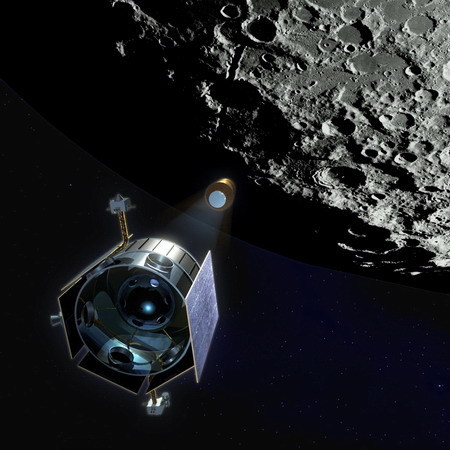 |
|
NASA's Lunar CRater Observation and Sensing Satellite (LCROSS) and its Centaur booster rocket are on course to crash into the moon in this artist's illustration released October 9, 2009. On final approach, the shepherding spacecraft and Centaur will separate. The Centaur will be the primary impactor and will create a debris plume that will rise about 6.2 miles (10 km) above the lunar surface. Following four minutes behind, the shepherding spacecraft will fly through the debris plume, collect and relay data back to Earth before impacting the lunar surface and creating a second debris plume. [Agencies]
|
WASHINGTON — Take that, moon!
NASA smacked two spacecraft into the lunar south pole Friday morning in a search for hidden ice. Instruments confirm that a large empty rocket hull barreled into the moon at 7:31 am, followed four minutes later by a probe with cameras taking pictures of the first crash.
But the big live public splash people anticipated didn't quite happen. Screens got fuzz and no immediate pictures of the crash or the six-mile plume of lunar dust that the mission was all about. The public, which followed the crashes on the Internet and at observatories, seemed puzzled.
NASA officials said their instruments were working, but live photos of the actual crash were missing. Some select photos should be ready by a 10 am press conference, they said.
But so far all NASA had was "images on the way in," said NASA spokesman Grey Hautaluoma.
Expectations by the public for live plume video were probably too high and based on pre-crash animations, some of which were not by NASA, project manager Dan Andrews told The Associated Press Friday morning 80 minutes after impact.
Another issue, one NASA thought was a good possibility going into Friday, was that the lighting was bad and work needs to be done on images to make them easier to see, Andrews said. Experts said the images could be essentially "gray against black," he said.
"What matters for us is: What is the nature of the stuff that was kicked up going in?" Andrews said. "All nine instruments were working fine and we received good data."
Andrews said the science team is pouring through the information — including what are supposed to be good images from ground-based telescopes on Earth — to answer the big question: Is there some form of water under the moon's surface that was dislodged? It will probably be two weeks before scientists will be certain about the answer, he said.
Before the crash, mission scientists said there was a chance that if it was really moist under the crater, they'd know about water within an hour. That's not the case now, Andrews said.
People who got up before dawn to look for the crash at Los Angeles' Griffith Observatory threw confused looks at each other instead.
Telescope demonstrator Jim Mahon called the celestial show "anticlimactic."
"I was hoping we'd see a flash or a flare," Mahon said.
About 100 miles northeast of Los Angeles, 70 elementary school students at the Lewis Center for Educational Research charter school in Apple Valley capped off their weeklong "moon camp" experience by rising early to watch NASA television along with 300 members of the public.
"It was cool seeing actual pictures of the moon live," said 10-year-old Jackson Bridges, but he added: "I wanted to see the debris flying out. It was still interesting to watch, but it was less interesting without the flying debris."
The first and much bigger crash was supposed to hit with the force of 1.5 tons of TNT into crater Cabeus and create a mini-crater about half the size of an Olympic pool. The second crash was to be about one-third as strong.
The idea is to confirm the theory that water — a key resource if people are going to go back to the moon — is hidden below the barren moonscape.
The images were to come from the probe itself. The probe is LCROSS, short for Lunar Crater Observation and Sensing Satellite and pronounced L-Cross. It had five cameras and four other pieces of equipment to look for ice or any form of water as it dove through the dust storm created by the empty hull.
Minutes before the first crash, NASA was riding high, reporting no trouble at the Ames Research Center in California, where the mission was being controlled.
"Everything is working so very well," NASA's Victoria Friedensen, a manager in NASA's exploration office, said minutes before the one-two smack.

